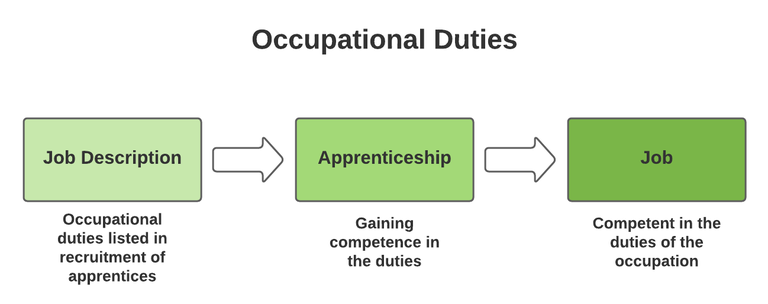Mapping duty-based apprenticeship standards to SFIA
The approach for mapping SFIA skills and skill levels to duty-based apprenticeship standards. Includes mapping of SFIA levels of responsibility to England Apprenticeship Level.
Duties
Duty based apprenticeship standards are developed to support identifiable occupations. Each occupation must be...
- in demand in the labour market
- transferable to a range of other employers
- secure long term earnings potential, greater security and capability to progress and meet the standards of a range of employers rather than the needs of one employer.
The occupational profile must fully define occupational competence for a new entrant to the occupation and be recognised by a range of employers and people practising the occupation.
The occupation is described in terms of...
- an occupation title
- an occupation profile
- a set of duties.
Duties describe what someone in the occupation ‘usually’ does in the workplace.
- They are sometimes called competences or activities.
- They are what you would find listed in a job description.
- The occupational profile will list around 10 to 20 duties.
Each duty statement will start with a verb, provide workplace context, and give examples to help understanding ensure they are not phrased skills or responsibilities.
- In many cases, a duty statement will map to a sentence or phrase within a SFIA skill definition at a corresponding level of responsibility.

Level of Responsibility
After completing their apprenticeship, an apprentice will have the competence to enable them to work in the described role for most employers. This requires the duties to be set at an appropriate level. Individual employer’s roles may have different duties, more duties, or less duties than those that were identified as needed for the apprenticeship standard.
The Institute for Apprenticeships and Technical Education maintain their own definition of levels
- These can be aligned with SFIA levels of responsibility
- Standards available for delivery in the digital occupations are at apprenticeship levels 3-6.
|
England Apprenticeship Level |
Description |
Apprentice occupational competence statement |
Apprentice autonomy and accountability statement |
Associated SFIA level of responsibility |
|
3 |
Technical |
Occupational competence which involves the application of knowledge and understanding, skills and methods in a broad range of varied work activities, performed in a variety of contexts most of which are complex and non-routine Address problems that, while well defined, may be complex and nonroutine.
|
Take responsibility for initiating and completing tasks and procedures including, where relevant, responsibility for supervising or guiding others.
Exercise responsibility, autonomy and judgement within limited parameters. |
2 - Assist |
|
4 |
Higher Technical |
Occupational competence which involves the application of knowledge and understanding, skills and methods in a broad range of complex or technical work activities, performed in a variety of contexts.
Address problems which are complex and non-routine while normally fairly well defined.
|
Take responsibility for courses of action, including, where relevant, responsibility for the work of others and allocation of resources.
Exercise responsibility, autonomy and judgement within broad but generally well-defined parameters. |
3 - Apply |
|
5 |
Professional |
Occupational competence which involves the application of theoretical and/or technological knowledge, understanding, skills and methods across a wide and often unpredictable variety of contexts.
Address broadly defined, complex problems.
|
Take responsibility for planning and developing courses of action including, where relevant, responsibility for the work of others and allocation of resources.
Exercise responsibility, autonomy and judgement within broad parameters Accountability for the analysis and diagnosis, design, planning, execution and evaluation.
|
4 - Enable |
|
6 |
Occupational competence which involves the application of advanced theoretical and/or technological knowledge, understanding, skills and methods across a wide and often unpredictable variety of contexts.
Address problems that have limited definition and involve many interacting factors.
|
Take responsibility for planning and developing courses of action that are capable of underpinning substantial changes or development Initiate and lead tasks and processes, taking responsibility where relevant, for the work and roles of others and the allocation of substantial resources.
Exercise broad autonomy and judgement. |
Mapping a duty
An example of a single duty from a level three apprenticeship standard mapped to SFIA.
|
Duty – as taken from apprenticeship standard at level 3
|
Skills supporting the duty – as taken from apprenticeship standard at level 3 |
SFIA Alignment (Skill & Level) |
|
Conduct the installation and maintenance of technical security controls in accordance with relevant procedures and standards. |
Follow information security procedures
Maintain information security controls
Follow technical procedures to install and maintain technical security controls
|
Security administration (SCAD) Level 3 SCAD-3 |
The definition of Security administration (SCAD) at level 3 is:
Investigate minor security breaches in accordance with established procedures. Assists users in defining their access rights and privileges. Performs non-standard security administration tasks and resolves security administration issues.
The duty definitions in apprenticeship standards provide a more detailed description than the SFIA definition.
- So while the mapping can be conducted, it is an approximation rather than a complete alignment.
- This is similar to the way duties/responsibilities on a typical job description aligns to to SFIA.
Depending on the nature of the apprenticeships standards they may map to a single SFIA skills or multiple SFIA skills.